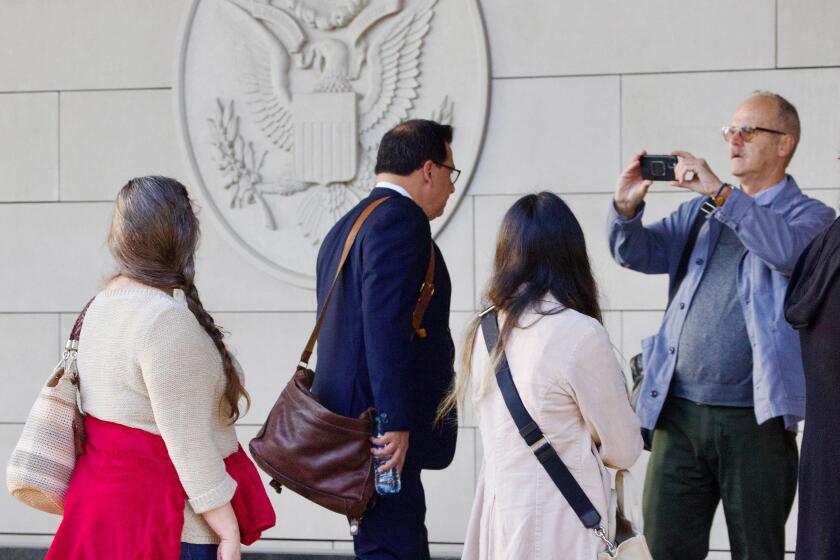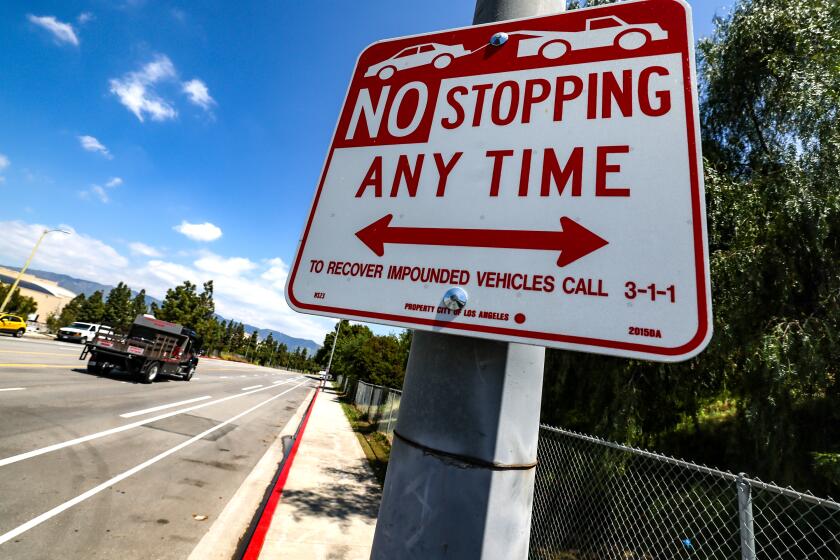Beverly Hills doesn’t want to miss the subway
Beverly Hills officials, sensing that a subway to the sea is inevitable, want to ensure the train doesn’t pass them by.
They are preparing to select a route and two station locations to best serve residents, as well as business owners and their employees.
It doesn’t seem to matter that the city has little say over the path of the proposed 13-mile subway that would travel between downtown Los Angeles and Santa Monica. Or that the Los Angeles County Metropolitan Transportation Authority, which would design, build and operate the subway, is still at least a year or two away from picking the route.
Forget, too, that no money has been set aside for the $5-billion project. Or that using federal funds to tunnel under Wilshire Boulevard still is illegal.
Beverly Hills residents, some of whom once opposed a subway, may be set to endorse a Wilshire Boulevard route from Western Avenue that would include one station at La Cienega Boulevard, and another between Beverly and Rodeo drives.
At community meetings, city leaders have confronted residents’ fears of subway crime and potential terrorism. They warn naysayers that, without a subway, traffic on the Westside will only get worse.
“There is an incredible sea change of attitude from resistance to support for the subway,” said Allan Alexander, a former Beverly Hills mayor who co-chairs the city’s mass transit panel.
Mayor Steve Webb is leading the charge.
He’s trying to put Beverly Hills in the best position to lobby federal, state and local officials for the money needed to build the rail line and to make sure it goes through his city.
Webb directed Alexander’s subway study committee to “determine what’s in our best interest.”
The subway study committee’s tentative endorsement of the route through the city is to be finalized next month and sent to the City Council for consideration at its January meeting.
A consultant hired by Beverly Hills said Wilshire Boulevard was chosen because it is surrounded by high-density residential and commercial development. It is the county’s most heavily traveled transit corridor, according to the MTA.
The committee considered but rejected a route along Santa Monica Boulevard from the subway’s Hollywood Boulevard and Highland Avenue station.
Last year, during his campaign for Los Angeles mayor, then-City Councilman Antonio Villaraigosa promised to restart the Westside subway project -- more than two decades after it had been derailed.
Longtime subway opponents Rep. Henry A. Waxman (D-Los Angeles), whose district includes parts of West Los Angeles, and Los Angeles County Supervisor Zev Yaroslavsky, who represents the Westside, now are working with Villaraigosa to try to complete the east-west rail line.
But that’s still several years away. First, the proposed subway must be added to the MTA’s long-range plan -- an essential element for federal funding -- and given a high priority.
Even with the MTA board’s endorsement, the proposed Red Line subway extension faces stiff competition for construction money.
It will have to vie with plans to extend the Expo Line from Culver City to Santa Monica, the Gold Line through the San Gabriel Valley to the Ontario International Airport and the Green Line from El Segundo to Los Angeles International Airport.
Meanwhile, the agency’s planners are dusting off old studies, dating to 1994. Planning alone could take up to two years to complete. The MTA board recently authorized a mere $100,000 to hire a full-time planner to oversee the project.
That’s all the money currently dedicated to building the subway to the sea. Efforts by Waxman to overturn a federal ban on subway funding along Wilshire are stalled in the U.S. Senate.
Waxman introduced the measure after experts concluded last year that a subway could be built without risk of another methane explosion like the one that ripped through a Fairfax-area clothing store in 1985. Although no one was killed, concerns about the blast helped lead to the stopping of subway construction.
There is another funding complication. In 1998, Los Angeles County voters, in a move led by Yaroslavsky, barred the use of transportation sales tax revenue for tunneling.
No one is suggesting that ban be lifted. Instead, transit officials, including Yaroslavsky, believe local money may be used for non-tunneling parts of the subway project.
Subway advocates are optimistic, especially with passage earlier this month of a $20-billion state infrastructure bond issue.
But critics, such as the Bus Riders Union, argue that bond money should be used to improve bus service.
To make it all happen, MTA officials, who rarely proceed without local support for regional transit projects, welcome the city of Beverly Hills’ early efforts to rally support.
“The seriousness and detail of their work shows their commitment for our common vision for improving transit service,” Villaraigosa, an MTA board member, said in a statement last week.
Alexander, a longtime subway advocate, believes mass transit is essential to conveniently ferrying many thousands of workers and visitors in and out of the city daily.
“It will allow people to come to work in the city, shop in the city, visit the city without bringing more cars to the city,” he said.
The population of Beverly Hills, with just 35,000 residents, swells weekdays to 250,000. Nearly 28,000 people a day board buses along Wilshire Boulevard within the city’s limits.
“I’m hoping that by our taking the initiative in this regard that Century City, Mid-Wilshire, Westwood and even Santa Monica will begin focusing on this,” Alexander said.
Beverly Hills officials may still have to persuade some residents. At a recent public meeting, one resident fretted that subway stops create potential terrorist targets. Another expressed concern about transit-related crime.
Overall, however, the tide seems to have turned.
“Anything that we can do to get cars off of our streets will be a plus for the quality of the life for the residents as well as assist the businesses,” resident Joe Safier said at a meeting this month.
The business community also is on board.
“Gridlock is such a problem on the Westside that it must be relieved, and we must be part of the equation,” Dan Walsh, chief executive of the Beverly Hills Chamber of Commerce, said Friday.
Chamber members suspect the traffic congestion they encounter daily could someday discourage visitors from shopping, eating and doing other business in their city.
It also could make it difficult to attract workers.
“We have to make it a piece of cake to get here,” Walsh said.
*
More to Read
Start your day right
Sign up for Essential California for news, features and recommendations from the L.A. Times and beyond in your inbox six days a week.
You may occasionally receive promotional content from the Los Angeles Times.






